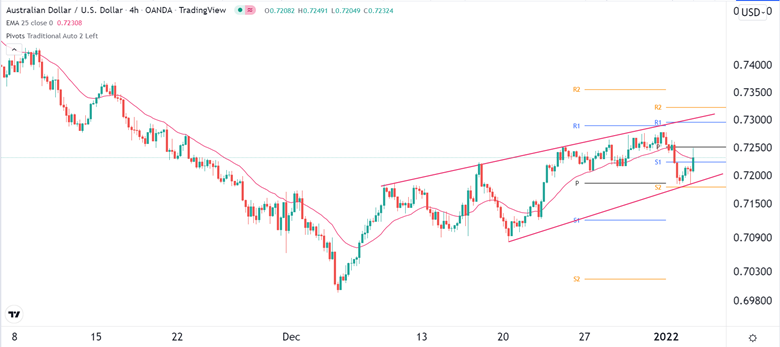Bullish View
Buy the AUD/USD pair and set a take-profit at 0.7300.
Add a stop-loss at 0.7185.
Timeline: 1-2 days.
Bearish View
Set a sell-stop at 0.7200 and a take-profit at 0.7150.
Add a stop-loss at 0.7250.
The AUD/USD pair tilted upwards as investors and analysts priced in ending of Australia’s quantitative easing (QE) even as the number of Omicron cases rose. The pair is trading at 0.7237, which was slightly above this week’s low of 0.7183.
Australian QE Nearing its End
Like other major central banks, the Reserve Bank of Australia (RBA) implemented some important measures in a bid to cushion the economy. The bank decided to lower interest rates to a record low. It also decided to implement a historic $326 billion quantitative easing program.
Now, analysts believe that the bank will terminate the QE program as soon as next month. A survey of 30 economists by the Australian Financial Review showed that most of them expect that the bank will end QE in February and then implement the first hike in June 2023.
A third of analysts expect that the bank will hike in the third or fourth quarter of the year. This is at odds with what the bank has forecasted. In the most recent decision, the bank said that it will only hike when actual inflation moves between the 2 to 3% range. It estimates that this figure will be reached in 2023. Economists polled by AFR expect that inflation will rise to 2.44% this year.
At the same time, most analysts downgraded the forecast for the AUD/USD pair. They see the pair rising to 0.73 by June this year. In the September survey, these analysts had a median estimate of 0.7400.
They pointed to the ongoing divergence between the RBA and the Federal Reserve. The Fed has hinted that it will implement three rate hikes this year.
Looking ahead, the next key catalyst for the AUD/USD pair will be the latest US jobs numbers from the United States.
AUD/USD Forecast
The four-hour chart shows that the AUD/USD pair has been in a bullish trend in the past few days. The pair has risen by about 3.45% from its lowest level in December. It has also moved between the ascending trend line that is shown in red. Also, the pair has risen slightly above the first support of the standard pivot points. It is also along the 25-day moving averages level.
Therefore, the pair will likely remain in this range today as investors refocus on the upcoming US jobs numbers.

